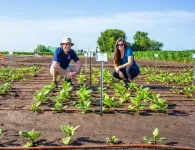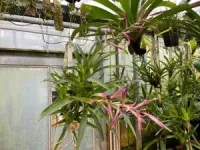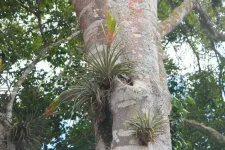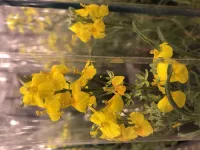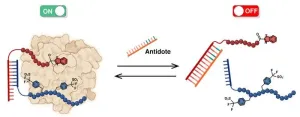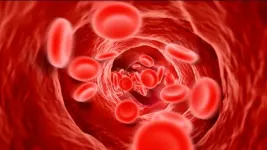(Press-News.org) It is possible to engineer increased mesophyll conductance in plants according to new research from the University of Illinois. Mesophyll conductance plays a key role in photosynthesis and refers to the ease with which CO2 can diffuse through a leaf’s cells before reaching the location where it is ultimately turned into sugar to feed the plant (carbon fixation). CO2 faces barriers as it moves through the leaf, including its own cell walls. Researchers from the Long Lab found that by increasing permeability and slightly reducing the thickness of cell walls, they could increase CO2 diffusion and uptake in a model crop.
“This is one of the few successful tests of concept showing that we can engineer an increase in mesophyll conductance and have it result in increased photosynthesis in the field,” said Coralie Salesse-Smith, a postdoctoral researcher in Long Lab and lead author on a paper about the research, recently published in the Plant Biotechnology Journal. “Theory shows us that increasing mesophyll conductance to increase photosynthesis can be achieved without the cost of more water. This is important considering the urgent need for increased crop production and sustainable water use.”
Photosynthesis is the natural process all plants use to convert sunlight, water, and carbon dioxide into energy and yields. CO2’s journey to becoming useful sugar (energy) for the plant, begins when it passes through tiny holes in the leaves known as stomata. In order for the CO2 to reach the chloroplast, (where it is turned into sugar), it must travel through a number of barriers, including the cell wall. The team hypothesized that if they could improve CO2 diffusion across the cell wall by making these barriers easier to cross, it would improve mesophyll conductance and in turn photosynthetic efficiency. Increasing mesophyll conductance means that more CO2 will be available for the plant to turn into food. A previous paper by Salesse-Smith’s Realizing Increased Photosynthetic Efficiency (RIPE) colleagues showed that thinner cell walls are associated with higher mesophyll conductance. This suggests that intentionally decreasing the thickness of the walls could change how easily CO2 moves through leaves, potentially increasing photosynthesis. Inspired by this paper, Salesse-Smith wanted to test this idea in a model plant.
After a review of the literature, Salesse-Smith narrowed her focus to overexpressing, or increasing the amount of, CGR3, a gene that has been shown to alter cell wall components. This gene was inserted into a tobacco species and grown alongside plants without the gene in a field trial during the 2022 growing season. Tobacco was used as a model plant because it is easier to work with in laboratory and field settings, and also because it allowed the researchers to test the genetics at a quicker pace than with a food crop.
“Targeting the cell wall was very important because it is one of the main components limiting mesophyll conductance. Decreasing its thickness and making it more permeable would make it easier for CO2 to get to the site of carbon fixation,” said Salesse-Smith, RIPE postdoctoral researcher in the Long Lab at the University of Illinois Urbana- Champaign. “By over-expressing the targeted gene, we were able to decrease cell wall thickness and increase its permeability which, as we hypothesized, did end up increasing mesophyll conductance and, in turn, photosynthesis.”
RIPE, which is led by Illinois, is engineering crops to be more productive by improving photosynthesis, the natural process all plants use to convert sunlight into energy.
The plants overexpressing the CGR3 gene showed a decrease in cell wall thickness of 7-13% and an increase in porosity of 75% when compared to the plants without this added gene. The team achieved their goal of making changes to the cell wall, but the true measure of success was when the data also showed an 8% increase in photosynthesis in the field.
“We hoped this modification would allow for more CO2 to get into the chloroplast and be used to create energy in the form of sugar, and that is what happened, but just because it worked in a model crop doesn’t mean you get the same results with a food crop,” said Salesse-Smith. “It is important to test what happens in soybean to see if the same improvements in mesophyll conductance and photosynthesis will be achieved, and if that leads to improvements in yield.”
Armed with these results, the team is working to test this modification in soybean, to see if increased photosynthesis, water use efficiency, and yield can be obtained in a food crop. Soybean field trials could take place as early as the 2025 growing season.
It is possible to engineer increased mesophyll conductance in plants according to new research from the University of Illinois. Mesophyll conductance plays a key role in photosynthesis and refers to the ease with which CO2 can diffuse through a leaf’s cells before reaching the location where it is ultimately turned into sugar to feed the plant (carbon fixation). CO2 faces barriers as it moves through the leaf, including its own cell walls. Researchers from the Long Lab found that by increasing permeability and slightly reducing the thickness of cell walls, they could increase CO2 diffusion and uptake in a model crop.
“This is one of the few successful tests of concept showing that we can engineer an increase in mesophyll conductance and have it result in increased photosynthesis in the field,” said Coralie Salesse-Smith, a postdoctoral researcher in Long Lab and lead author on a paper about the research, recently published in the Plant Biotechnology Journal. “Theory shows us that increasing mesophyll conductance to increase photosynthesis can be achieved without the cost of more water. This is important considering the urgent need for increased crop production and sustainable water use.”
Photosynthesis is the natural process all plants use to convert sunlight, water, and carbon dioxide into energy and yields. CO2’s journey to becoming useful sugar (energy) for the plant, begins when it passes through tiny holes in the leaves known as stomata. In order for the CO2 to reach the chloroplast, (where it is turned into sugar), it must travel through a number of barriers, including the cell wall. The team hypothesized that if they could improve CO2 diffusion across the cell wall by making these barriers easier to cross, it would improve mesophyll conductance and in turn photosynthetic efficiency. Increasing mesophyll conductance means that more CO2 will be available for the plant to turn into food. A previous paper by Salesse-Smith’s Realizing Increased Photosynthetic Efficiency (RIPE) colleagues showed that thinner cell walls are associated with higher mesophyll conductance. This suggests that intentionally decreasing the thickness of the walls could change how easily CO2 moves through leaves, potentially increasing photosynthesis. Inspired by this paper, Salesse-Smith wanted to test this idea in a model plant.
After a review of the literature, Salesse-Smith narrowed her focus to overexpressing, or increasing the amount of, CGR3, a gene that has been shown to alter cell wall components. This gene was inserted into a tobacco species and grown alongside plants without the gene in a field trial during the 2022 growing season. Tobacco was used as a model plant because it is easier to work with in laboratory and field settings, and also because it allowed the researchers to test the genetics at a quicker pace than with a food crop.
“Targeting the cell wall was very important because it is one of the main components limiting mesophyll conductance. Decreasing its thickness and making it more permeable would make it easier for CO2 to get to the site of carbon fixation,” said Salesse-Smith, RIPE postdoctoral researcher in the Long Lab at the University of Illinois Urbana- Champaign. “By over-expressing the targeted gene, we were able to decrease cell wall thickness and increase its permeability which, as we hypothesized, did end up increasing mesophyll conductance and, in turn, photosynthesis.”
RIPE, which is led by Illinois, is engineering crops to be more productive by improving photosynthesis, the natural process all plants use to convert sunlight into energy.
The plants overexpressing the CGR3 gene showed a decrease in cell wall thickness of 7-13% and an increase in porosity of 75% when compared to the plants without this added gene. The team achieved their goal of making changes to the cell wall, but the true measure of success was when the data also showed an 8% increase in photosynthesis in the field.
“We hoped this modification would allow for more CO2 to get into the chloroplast and be used to create energy in the form of sugar, and that is what happened, but just because it worked in a model crop doesn’t mean you get the same results with a food crop,” said Salesse-Smith. “It is important to test what happens in soybean to see if the same improvements in mesophyll conductance and photosynthesis will be achieved, and if that leads to improvements in yield.”
Armed with these results, the team is working to test this modification in soybean, to see if increased photosynthesis, water use efficiency, and yield can be obtained in a food crop. Soybean field trials could take place as early as the 2025 growing season.
END
Engineered increase in mesophyll conductance improves photosynthetic efficiency in field trial
2024-04-30
ELSE PRESS RELEASES FROM THIS DATE:
Unlocking the genetic mysteries behind plant adaptation: New insights into the evolution of a water-saving trait in the pineapple family (bromeliaceae)
2024-04-30
Researchers at the University of Vienna, along with collaborators from France, Germany, Switzerland and the USA, have achieved a major breakthrough in understanding how genetic drivers influence the evolution of a specific photosynthesis mechanism in Tillandsia (air plants). This sheds light on the complex actions that cause plant adaptation and ecological diversity. The results of their study are now published in Plant Cell.
Some plant species have evolved a water-saving trait called Crassulacean Acid Metabolism (CAM). CAM plants like most ...
Childcare pick-up: a 1-hour window to build healthier eating habits
2024-04-30
Millions of working parents know the routine: bustle the kids off to childcare in the morning, work all day, then fight the daily traffic jams to get the kids back home. Something to drink, maybe a snack to munch, can help ease the commute.
Understandably, few parents take the time to think about the nutrients or calories involved, but experts at Cincinnati Children’s decided to take a closer look. Their eyebrow-raising findings were published April 27, 2024, in the journal Children’s Health Care.
The researchers took a fresh look at older data contained in daily food journals kept by more than 300 families of children who attended 30 childcare ...
MD Anderson and Replay announce FDA clearance of IND application for first-in-class PRAME-targeted TCR NK cell therapy for hematological malignancies
2024-04-30
HOUSTON, SAN DIEGO and LONDON ― The University of Texas MD Anderson Cancer Center and Replay today announced that the Food & Drug Administration (FDA) has issued a ‘safe to proceed’ for the Investigational New Drug (IND) application for PRAME TCR/IL-15 NK (SY-307), an engineered T cell receptor natural killer (TCR NK) cell therapy for relapsed/refractory myeloid malignancies. MD Anderson is the IND sponsor.
PRAME TCR/IL-15 NK (SY-307) is being developed by Syena, an oncology-focused product company launched by Replay and MD Anderson based on the scientific discoveries of Katy ...
Discovery of mechanism plants use to change seed oil could impact industrial, food oils
2024-04-30
PULLMAN, Wash. -- Researchers have discovered a new mechanism of oil biosynthesis and found a way to genetically engineer a type of test plant to more efficiently produce different kinds of seed oil that it otherwise wouldn't make.
While the engineering is proof-of-concept, this discovery could lead to improved production of valuable oils used in food and by a range of industries. The study, led by Washington State University researchers, was published in the journal Nature Communications.
“Scientists have been working on producing ...
A new anticoagulant with no risk of bleeding
2024-04-30
Anticoagulant treatments are crucial for managing many conditions, such as heart disease, stroke and venous thrombosis. Current options, however, carry an inherent risk of serious bleeding due to trauma or unforeseen events. A team from the University of Geneva (UNIGE) and the University of Sydney has developed a new anticoagulant, designed to have an on-demand reversible activity, with a fast-acting ‘‘antidote’’. This approach could revolutionise the use of anticoagulants in surgery or other applications. The mechanism of activation and deactivation of the active principle ...
Genetic adaptations have impacted the blood compositions of two populations from Papua New Guinea
2024-04-30
Papua New Guinea (PNG) has a wide range of environments, each presenting unique challenges to human survival. Highlanders and lowlanders of PNG are striking examples of populations facing distinct environmental stress. Whereas the highlanders encounter low oxygen availability due to altitude, the lowlanders are exposed to specific pathogens that are absent in the highlands, such as malaria. Despite these strong environmental pressures, the specific adaptations of these populations have remained overlooked. A new study published in Nature Communications on Tuesday, 30 April 2024 sheds light on the genetic adaptations of Papua New Guineans in response to their unique environmental ...
Abrupt permafrost thaw intensifies warming effects on soil CO2 emission
2024-04-30
According to a recent study published in Nature Geoscience, scientists have found that soil carbon dioxide (CO2) emissions are more sensitive to climate warming in permafrost-collapsed areas than in non-collapsed areas.
This study, based on field warming experiments combined with laboratory incubation of soils from a large-scale sampling, provides new insights about permafrost carbon–climate feedback in the context of future climate warming.
Warmer temperatures have led to rapid permafrost thawing in high-latitude and -altitude permafrost regions. Abrupt permafrost thaw, ...
Scientists discover over 100 new genomic regions linked to blood pressure
2024-04-30
National Institutes of Health researchers and collaborators have discovered over 100 new regions of the human genome, also known as genomic loci, that appear to influence a person’s blood pressure. Results of the study also point to several specific genomic loci that may be relevant to iron metabolism and a type of cellular receptor known as adrenergic receptors.
The study, published in Nature Genetics, is one of the largest such genomic studies of blood pressure to date, including data from over 1 ...
Researchers identify over 2,000 genetic signals linked to blood pressure in study of over one million people
2024-04-30
The Queen Mary-led study reveals the most detailed picture yet of genetic contributors to blood pressure. The findings lead to improved polygenic risk scores, which will better predict blood pressure and risk for hypertension.
Researchers led by Queen Mary University of London and supported by the National Institute for Health and Care Research (NIHR) have discovered over a hundred new regions of the human genome, also known as genomic loci, that appear to influence a person’s blood pressure. In total, over 2,000 independent genetic signals for blood pressure are now reported, demonstrating that blood pressure is a highly complex trait influenced by thousands ...
Scientists find cancer-like features in atherosclerosis, spurring opportunity for new treatment approaches
2024-04-30
Researchers have discovered that the smooth muscle cells that line the arteries of people with atherosclerosis can change into new cell types and develop traits similar to cancer that worsen the disease. Atherosclerosis is characterized by a narrowing of arterial walls and can increase risk of coronary artery disease, stroke, peripheral artery disease, or kidney disorders. The findings, supported by the National Institutes of Health (NIH), could pave the way for the use of anti-cancer drugs to counteract the tumor-like mechanisms ...
